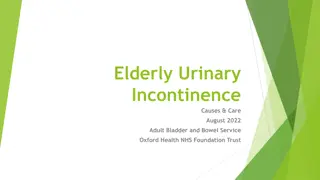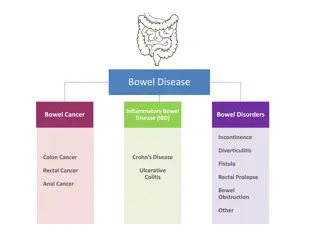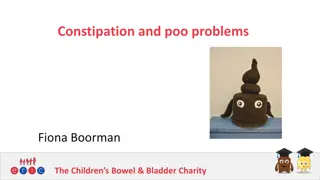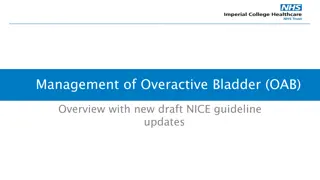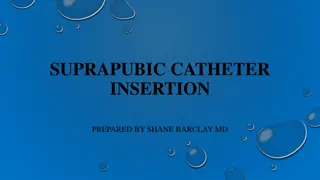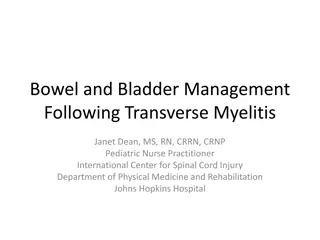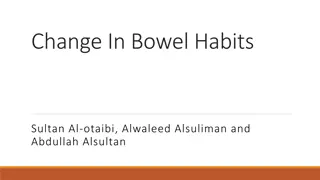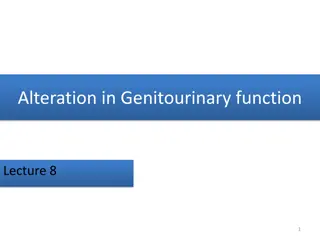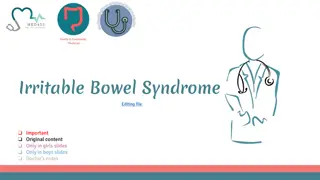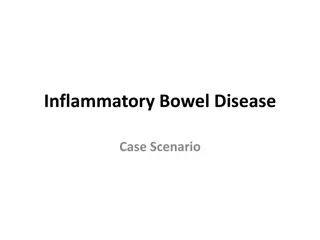Stroke Continence Protocols for Managing Bladder and Bowel Function After Stroke
This protocol outlines the management of urinary and bowel incontinence in stroke patients, emphasizing high nursing care levels and avoiding unnecessary catheterization. It discusses normal bladder functions, urinary dysfunction prevalence post-stroke, and interventions for promoting continence. Urinary issues like retention, urge incontinence, and urinary tract infections are common after a stroke, necessitating early identification and appropriate management.
Download Presentation

Please find below an Image/Link to download the presentation.
The content on the website is provided AS IS for your information and personal use only. It may not be sold, licensed, or shared on other websites without obtaining consent from the author.If you encounter any issues during the download, it is possible that the publisher has removed the file from their server.
You are allowed to download the files provided on this website for personal or commercial use, subject to the condition that they are used lawfully. All files are the property of their respective owners.
The content on the website is provided AS IS for your information and personal use only. It may not be sold, licensed, or shared on other websites without obtaining consent from the author.
E N D
Presentation Transcript
STROKE CONTINENCE PROTOCOLS Vision: Bladder continence identified and managed in stroke from acute admission through rehabilitation. Scope: All clinical staff, patients and patient s families. Background: Urinary incontinence (U.I.) is common following stroke (reportedly 32-79% of patients pre-existing for some). (Williams, Perry and Watkins, 2010) Bowel function is also often affected, especially constipation which is related particularly to functional ability/immobility. Policy Statements: 1.Urinary incontinence is not an indication for an indwelling catheter (IDC). Patients should not have an IDC inserted in the first 48 hours unless indicated to relieve retention. 2.Bladder and bowel incontinence should be identified and managed in the acute phase of stroke by high levels of nursing care. (see associated documents) 3.Intermittent catheterisation where indicated. Associated documents: 1.Intermittent catheterisation protocol 2.Urinary Assessment (Dunedin s by permission) 3.Interventions based on U.I. types and to promote urinary continence Definitions: Retention = >500mls on bladder scanner
Normal Bladder Function Bladder (detrusor) and urethral functions are coordinated for the storage and emptying of urine (Borrie 1998). This involves areas of the central nervous system and multiple peripheral nervous systems as listed below: Sympathetic nervous system relaxes the detrusor muscle while internal urethral sphincter control is maintained by sympathetic alpha- adrenoreceptors Parasympathetic acetylcholine receptors mediate detrusor contracture. Somatic (voluntary) nervous system innervates the pelvic floor muscles, including the external urethral sphincter.
Normal Bladder Function (continued) The micturition centre in the brainstem (pons) monitors when the bladder is filling and controls the sacral reflex when bladder filling reaches a certain level. The micturition centre in the frontal lobes provides conscious input to the pontine micturition centre allowing the inhibition of urination until the time of voluntary control.
Normal Bladder Function (continued) Normally, we are unaware of bladder fullness until a capacity of about 300 cc is reached. The need to void is then inhibited or controlled by the frontal lobes.
Urinary Dysfunction 40-60% of people admitted to hospital after a stroke can have problems with Urinary incontinence, with 25% of stroke survivors still having problems on hospital discharge, and 15% remaining incontinent after one year (Barrett 2001). Not all the studies excluded people with pre-morbid incontinence, however: The most frequently occurring voiding abnormalities associated with a 1. stroke have been identified as urinary frequency, urge incontinence and urinary retention (Marinkovic and Badlani 2001). Urinary tract infection is not uncommon in stroke patients. 2.
Urinary Incontinence is a strong predictor of poor functional recovery, discharge to long-term care, and limited resumption of social participation (Dumoulin et al. 2007). While there are problems with attributing better stroke outcome to improvements in continence, it is possible that recovery from incontinence may improve morale and self esteem and therefore speed overall stroke recovery (Barer 1989; Patel 2001). Conversely, stroke outcome is better in those stroke survivors who remain continent or regain continence (Barer 1989). Improvement is common over time (Marinkovic 2001), which suggests that problems with continence may be transient in some stroke survivors, and/or amenable to intervention.
Mechanisms most commonly responsible for urinary incontinence Gelber et al. (1993) suggested that three mechanisms were responsible for incontinence post stroke (van Kuijk et al. 2001). These included: Detrusor hyper-reflexia with urge incontinence and bladder hyper- reflexia from disrupted neuromicturition pathways (frontal lobe or pontine micturition centers) (Nazarko 2003, Fader & Craggs 2003). Incomplete bladder emptying with overflow incontinence and bladder hypo-reflexia from concurrent neuropathy or from the concurrent medications, such as diuretics (Fader & Craggs 2003). Incontinence from stroke-related motor, cognitive and language deficits, despite normal bladder function.
Detrusor Hyperreflexia Cortical and subcortical strokes generally result in an unstable or hyper- reactive detrusor (Borrie 1998). Borrie (1998) has noted that unstable detrusor contractions occur with little warning and result in symptoms of urinary urge incontinence. The bladder volume at which this occurs can be variable but it is usually lower than the volume at which a person with a normally functioning bladder would normally have a strong urge to void (Borrie 1998). He comments that detrusor hyper-reflexia is not inevitable following a stroke. It has been noted that urinary incontinence is more common with larger strokes with a greater number of accompanying deficits and is closely associated with bowel incontinence, dysphagia and overall functional level, all markers of more severe strokes.
Urinary Retention Urinary retention is common following an acute stroke (21-47%). Potential contributing factors include difficulty with communication, mobility and decreased consciousness. Other contributing factors may be a hyper-reflexic bladder, as seen in diabetic neuropathy, or an obstruction such as prostatic hypertrophy. Occasionally urinary retention will persist in very severe stroke patients, often in patients with embolic strokes with no previous warnings.
Other Factors Contributing to Post- Stroke Incontinence Stroke results in a number of factors which can affect continence, but which Are often overlooked: Communication difficulties, particularly an inability to communicate voiding needs, either due to aphasia, dysarthria or confusion/cognitive impairments. Mobility problems, such as hemiplegia make some patients dependent on caregivers to void in a socially appropriate manner. Lack of caregiver support may also make it difficult to toilet the stroke patients quickly enough.
Other Factors Contributing to Post- Stroke Incontinence (continued) Post stroke depression and confusion may result in a failure to communicate the need for assistance. Medications, such as diuretics can increase the frequency of the need to void; others can increase confusion, while still others such as anti hypertensive's may affect the autonomic nervous system leading to retention.
Risk Factors for Urinary Incontinence (Nazarko 2003, Brittain et al. 1999, Jorgensen et al. 2005). Severe strokes have a higher incidence of urinary incontinence. Premorbid history of urinary incontinence, i.e comorbidities. Motor weakness and mobility difficulties, including ataxia. Altered level of consciousness. Cognitive impairment Depression Elderly (Marinkovic and Badlani 2001). Gariballa (2003) found that patients with urinary incontinence at admission tended to be more undernourished and dehydrated, more impaired, at greater risk for infective complications and older than patients without urinary incontinence.
Course of Urinary Incontinence Brooks (2004) has noted that a stroke may exacerbate existing stress incontinence, a problem more common in women. Urinary incontinence was reported among 17% (n=213) of non-institutionalised post stroke survivors, an average of nine years post stroke, compared to 7% of control subjects without stroke (Jorgensen et al. 2005) (OR = 2.8, 95% CI 1.5-5.2). Incontinence post stroke often resolves without treatment in eight weeks (Borrie et al. 1986, Brocklehurst et al. 1985).
Urinary Tract Infection UTI is the most common medical complication in stroke rehabilitation. Risk factors include use of beta-blockers and high post-void residuals Urinary tract infections (UTI) are the most commonly encountered medical complication associated with stroke rehabilitation (Roth et al. 2001). Although age greater than 65, male sex, a history of prior stroke, stroke syndrome, use of -Blocker or antidepressants and a post void residual (PVR) of 150 ml or more have been reported as risk factors for the development of UTIs, Dromerick and Edwards (2003) only found an increased risk of UTI to be associated with -Blocker use (OR = 4.01, 95% CI 1.26-14.59) and PVR 150 ml (OR = 3.97, 95% CI 1.24- 9.53) among 120 stroke patients admitted to a rehabilitation service.
Post-Void Residual Urine Testing PVR is able to determine if bladder emptying is complete. PVR > 150 cc is generally regarded as abnormal. Increased PVRs increases the risk of urinary tract infections. Borrie (1998) notes that A true void residual (PVR) urine test is critical to determine if bladder emptying is complete... although in/out catherisation is the gold standard for determining the PVR urine, portable bladder ultrasound is practical, noninvasive and cost-effective (Chan 1993). A sterile culture from the catheter specimen would rule out urinary tract infection. Two consecutive residual urines of greater than 150ml suggest a significant degree of incomplete bladder emptying, and physical outlet obstruction should be ruled out by urology assessment with cystoscopy. There is no consensus as to what residual urine volume is definitively abnormal (Grosshans et al. 1993). Most would regard greater than 150 ml abnormal, but is depends to some degree on the volume of urine voided before catheterisation.
Diagnosis of Bladder Dysfunction Detrusor instability or hyper-reflexia with urge incontinence. Stress incontinence. Overflow incontinence with incomplete emptying. Mixed types of incontinence. Functional incontinence, due to non-urinary factors. Iatrogenic incontinence, due to drugs or restraints. The intervention used to manage urinary incontinence largely depends on the patient s history and type of incontinence. Due to the absence of strong evidence regarding treatment efficacy, Borrie (1998) has suggested using a stepwise approach, with behavioural interventions used as first line treatments followed by pharmacological and surgical interventions.
Diagnosis of Bladder Dysfunction (continued) This approach highlights the fact that patients should always be treated with the least invasive intervention option. There are few randomised controlled trials evaluating the efficacy of bladder management to treat urinary incontinence post stroke, although the issue has been studied in other patient populations. The choice will often be dictated by the stroke patient s type of incontinence.
Behavioural Interventions for Incontinence Scheduled voiding q 2-4 hours Fluid restriction Dumoulin et al. (2005) conducted a systematic review investigating the benefits of behavioural therapies used to treat urinary incontinence. The study included only four randomised controlled trials, a single cohort study and recommendations from three clinical practice guidelines. This study found limited evidence for the reduction of urinary incontinence in male stroke patients using combination treatment including bladder retraining with urge suppression and pelvic floor exercises. The authors concluded that although there is increasing recognition of the benefits of using behavioral approaches as treatment for stroke patients with a high occurrence of continual urinary incontinence, the evidence remains very limited for specific treatments used for stroke survivors with urinary incontinence.
Bladder Training Scheduled voiding programs follow a set schedule of voiding every 2-4 hours regardless of whether the patient needs to go because post stroke cortical awareness of bladder fullness is often reduced (Borrie 1998). Initiation of toileting in response to urgency, while shown to promote continence, often does not provide enough time to void especially when mobility is limited. Bladder training allows for lengthening of the voiding interval as the patient becomes consistently dry (Burgio and Paurgio 1986, Borrie 1998). However, Duncan et al. (2005) suggest that there is no evidence for or against a scheduled voiding program. These authors recommend an individualised bladder training program and the use of prompted voiding for incontinent stroke patients.
Bladder Training (continued) Pelvic Floor Exercises are designed to strengthen the pelvic floor muscles through repeated contraction and relaxation of specific muscle groups. Although these exercises were originally developed to manage stress incontinence, rapid contractions have also been found to help patients suppress the urgency wave of the relax bladder contraction (Borrie 1998).
Bladder Training (continued) Fluid Intake - The total measurable fluid intake should be approximately 1500 1800 ml per 24 hours. The use of intravenous fluids or a feeding tube may result in fluid loads greater than 2000 ml per day, which Will in turn compromise bladder continence (Borrie 1998).
Pharmacological Interventions for Incontinence Pharmacological treatment will depend on the cause of the stroke. The vast majority of bladder incontinence is due to detrusor hyper- reflexia due to central loss of inhibition. Drugs with anticholinergic actions are recommended in these cases, i.e Oxybutynin. For overflow incontinence due to detrusor inactivity, a cholinergic such as Bethanecol is recommended. For overflow incontinence due to outlet obstruction, an alpha- adrenergic blocker may be recommended.
Pharmacological Interventions for Incontinence (continued) Drug therapy should be considered an adjunct to behavioural therapy and should only be used when behavioural interventions are either inappropriate or have had an adequate trial. The side effects of anticholinergic medications are often underestimated, particularly in the post-stroke population. Therefore, the goal of pharmacological therapy should be to use the lowest dose to achieve the optimal effect with the fewest side effects (Borrie 1998). Post stroke detrusor hyper-reflexia treated with drugs with various degrees of Anticholinergic medications. These medications include, oxybutynin, propantheline and imipramine. These drugs should be started at a low dose and increased gradually
Pharmacological Interventions for Incontinence (continued) Propantheline supposedly does not cross the blood-brain barrier, with a theoretical advantage over other drugs which can lead to confusion. Tolterodine is another anticholinergic which is said to have less influence on salivary gland function and therefore less likely to lead to dry mouth as a complication. (Note that Tolterodine is not a subsidised drug in NZ). Borrie (1998) has also noted that for patients with poor detrusor contracture, Bethanechol may improve detrusor contracity (Sonda et al. 1979). It serves as an adjunct to intermittent catherisation. Bethanechol is discontinued if residual urines do not diminish, there is excessive sweating, asthmatic attacks, congestive heart failure and abdominal cramps.
Catheters for Bladder Dysfunction Catheters for bladder dysfunction should always be seen as a treatment of last resort. Intermittent catheterisation is the preferred option in urinary incontinence with overflow incontinence. An indwelling catheter should be limited to those patients with intractable urinary retention, continuous wetness (+/- skin breakdown) and those who have need of monitoring. Intermittent catheterisation is the preferred management option for patients suffering from urinary retention with overflow incontinence. The combined voided and residual volume should not exceed 500 ml. and the frequency of catheterisation should be monitored and adjusted if the residual volume changes. Long-term in- dwelling catheters are associated with several risks, such as chronic urinary bacteruria and bladder stones, and should only be used if intermittent catheterisation is impractical.
Catheters for Bladder Dysfunction (continued) Gresham et al. (1995) noted that use of indwelling catheters should be limited to patients with incontinence due to urinary retention that cannot be otherwise treated, severely impaired patients with skin breakdown, in whom frequent bed or clothing changes would be difficult or painful and in patients in whom incontinence interferes with monitoring of fluid and electrolyte balance. Brocklehurst et al. (1985) noted that 40% of patients regain continence during the first two weeks. The use of a catheter will inhibit that process. Again catheterisation should be reserved for exceptional circumstances (Nazarko 2003). Bjork et al. (1984), Sabanthan et al. (1985) and Wareen et al. (1982) observed the chronic use of indwelling catheters increases the risk of bacteria and urinary tract infection. Moreover, it has been shown that more than three-quarters of persons catheterised for three months or more will develop inflammatory bladder wall changes. While bacteraemia can be identified by urine culture, treatment with antibiotics should be reserved for those patients with symptomatic urinary tract
Intermittent Catheterisation: Purpose: to empty the bladder at normal intervals to preserve normal bladder tone and capacity, prevent overflow incontinence, and prevent residual urine accumulating, thereby reducing the chance of urinary tract infections. Procedure: when to catheterise is determined by fluid intake and output. Intake being 1500-2000mls per day and output 400-600mls with each catheterisation; and times adjusted so over distension does not occur.
If intake is 1400-1800ml/24hrs catheterisation should be 8hrly (0600/1400/2200) If intake 1800-2400ml/24hrs catheterisation should be 6hrly (0600/1200/1800/2400) If intake is 2400-3000/24hrs catheterisation should be 4hrly (0200/0600/1000/1400/1800/2200) After this level, an IDC should be considered until intake can be reduced as it is too difficult to maintain 4hrly catheterisation on a prolonged basis. Intermittent catheterisation is preferable to indwelling catheterisation, but may not be practical in the acute phase of stroke . (Sterile technique is essential.)



